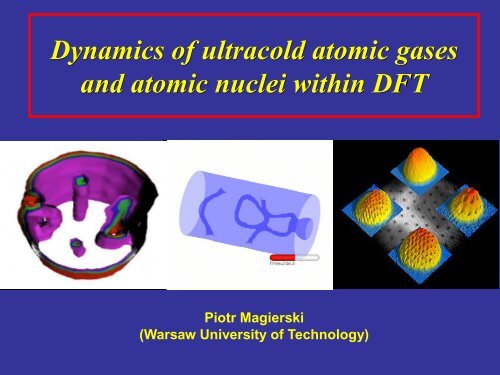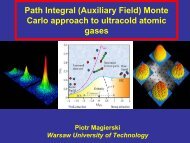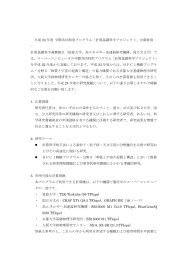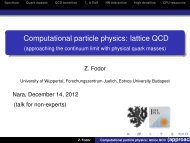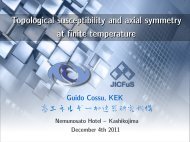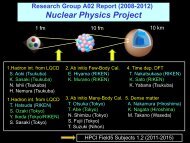Dynamics of ultracold atomic gases and atomic nuclei within DFT
Dynamics of ultracold atomic gases and atomic nuclei within DFT
Dynamics of ultracold atomic gases and atomic nuclei within DFT
You also want an ePaper? Increase the reach of your titles
YUMPU automatically turns print PDFs into web optimized ePapers that Google loves.
<strong>Dynamics</strong> <strong>of</strong> <strong>ultracold</strong> <strong>atomic</strong> <strong>gases</strong><br />
<strong>and</strong> <strong>atomic</strong> <strong>nuclei</strong> <strong>within</strong> <strong>DFT</strong><br />
Piotr Magierski<br />
(Warsaw University <strong>of</strong> Technology)
Collaborators:<br />
A. Bulgac - Seattle<br />
Y-L. (Alan) Luo - Seattle<br />
K.J. Roche – PNNL<br />
I. Stetcu - LANL<br />
Y. Yu - Wuhan<br />
GOAL:<br />
Description <strong>of</strong> fermionic superfluids far from<br />
equilibrium.<br />
Theoretical approaches to superfluid dynamics:<br />
- two-fluid hydrodynamics<br />
- L<strong>and</strong>au-Ginzburg model (or Gross-Pitaevski equations)<br />
- Density Functional Theory – extension to superfluid systems <strong>and</strong><br />
time-dependent phenomena.
Density Functional Theory (<strong>DFT</strong>)<br />
Hohenberg-Kohn theorem:<br />
Egs<br />
[ n( r)]<br />
particle density<br />
Local Density Approximation:<br />
<br />
<br />
2m<br />
<br />
( ) [ ( )] ( ) <br />
<br />
2<br />
3<br />
Egs<br />
d r r <br />
n r n r<br />
<br />
N<br />
N<br />
2 2<br />
<br />
i<br />
<br />
i<br />
i1 i1<br />
<br />
n( r) | ( r) | ( r) | ( r) |<br />
2<br />
<br />
<br />
i( r) U( r) <br />
i( r) <br />
i i( r)<br />
2m<br />
Kohn-Sham equations
SLDA - Extension <strong>of</strong> Kohn-Sham approach to<br />
superfluid Fermi systems<br />
pairing<br />
(anomalous) density<br />
Mean-field <strong>and</strong> pairing field are<br />
both local fields!<br />
(for sake <strong>of</strong> simplicity spin degrees<br />
<strong>of</strong> freedom are not shown)<br />
There is a problem!<br />
The pairing field diverges.<br />
One has to introduce position<br />
<strong>and</strong> momentum dependent<br />
running coupling constant.
Formalism for Time Dependent Phenomena: TDSLDA<br />
Density functional contains normal densities, anomalous density (pairing) <strong>and</strong> currents:<br />
Density<br />
functional for<br />
unitary Fermi<br />
gas<br />
Nuclear energy<br />
functional: SLy4,<br />
SkP, SkM*,…<br />
Both codes: SLDA <strong>and</strong> TDSLDA are formulated on the 3D lattice without any symmetry<br />
restrictions.<br />
SLDA generates initial conditions for TDSLDA.
Selected capabilities <strong>of</strong> the SLDA/TDSLDA codes:<br />
full 3D simulations with no symmetry restrictions<br />
number <strong>of</strong> evolved quasiparticle wave functions is <strong>of</strong> the order <strong>of</strong> the lattice size:<br />
O(10 4 )- O(10 6 )<br />
high numerical accuracy for spatial derivatives using FFTW<br />
for TD high-accuracy <strong>and</strong> numerically stable Adams–Bashforth–Milne 5 th order<br />
predictor-corrector-modifier algorithm with only 2 evaluations <strong>of</strong> the rhs per<br />
time step <strong>and</strong> with no matrix operations<br />
The time step is adjusted so the relative error in ABM method is between<br />
10 -7 -10 -15<br />
Eg. we evolve 4x136626=546504 coupled eigenvectors for 238 U on the lattice:<br />
50x50x80 fm (mesh size: 1.25fm) with energy cut<strong>of</strong>f 100MeV to an accuracy<br />
10 -8<br />
very fast I/O capabilities<br />
volumes <strong>of</strong> the order <strong>of</strong> (L = 80 3 ) capable <strong>of</strong> simulating time evolution <strong>of</strong> 42000<br />
neutrons at saturation density (possible application: neutron stars)<br />
capable <strong>of</strong> simulating up to times <strong>of</strong> the order <strong>of</strong> 10 -19 s (a few million time steps)<br />
Presented calculations for unitary Fermi gas required over 200,000 cores <strong>of</strong><br />
JaguarPF
SLDA for unitary Fermi gas<br />
SLDA – Superfluid Local Density Approximation<br />
SLDA energy density functional at unitarity<br />
Fermions at unitarity in a harmonic trap<br />
Total energies E(N)<br />
Bulgac, PRA 76, 040502(R) (2007)<br />
GFMC - Chang <strong>and</strong> Bertsch, Phys. Rev. A 76, 021603(R) (2007)<br />
FN-DMC - von Stecher, Greene <strong>and</strong> Blume, PRL 99, 233201 (2007)<br />
PRA 76, 053613 (2007)
A. Bulgac, M.M. Forbes, P. Magierski, in BCS-BEC crossover <strong>and</strong> the Unitary Fermi gas<br />
„Lecture Notes in Physics” v.836, p. 305, ed. W. Zwerger (2012)
Excitation <strong>of</strong> vortices through stirring<br />
dynamics<br />
<strong>of</strong> vortex rings<br />
Heavy spherical<br />
object moving<br />
through<br />
the superfluid<br />
unitary Fermi gas
A. Bulgac, M.M. Forbes, P. Magierski, in BCS-BEC crossover <strong>and</strong> the Unitary Fermi gas<br />
„Lecture Notes in Physics” v.836, p. 305, ed. W. Zwerger (2012)
Details <strong>of</strong> simulations <strong>of</strong> unitary Fermi gas:<br />
Lattice sizes: 48x48x48, 32x32x(96-196)<br />
Number <strong>of</strong> particles: 300-1800<br />
Number <strong>of</strong> evolved q.p. wave functions: 9500 - 41000
Road to quantum turbulence<br />
Classical turbulence: energy is transfered from large scales to small scales<br />
where it eventually dissipates.<br />
Kolmogorov spectrum: E(k)=C ε 2/3 k -5/3<br />
E – kinetic energy per unit mass associated with the scale 1/k<br />
ε - energy rate (per unit mass) transfered to the system at large scales.<br />
k - wave number (from Fourier transformation <strong>of</strong> the velocity field).<br />
C – dimensionless constant.<br />
Superfluid turbulence (quantum turbulence): disordered set <strong>of</strong> quantized vortices.<br />
The friction between the superfluid <strong>and</strong> normal part <strong>of</strong> the fluid serves as a source<br />
<strong>of</strong> energy dissipation.<br />
Problem: how the energy is dissipated in the superfluid system at small scales<br />
at T=0 - „pure” quantum turbulence<br />
Possibility: vortex reconnections → Kelvin waves → phonon radiation
Vortex reconnections<br />
Bulgac, Luo, Magierski, Roche, Yu, Science 332, 1288 (2011)<br />
More movies here:<br />
www.phys.washington.edu/groups/qmbnt/UFG/
Nuclear <strong>DFT</strong>
Nuclear dynamics from time dependent density functional theory<br />
Photoabsorption cross section<br />
for heavy, deformed <strong>nuclei</strong>.<br />
(gamma,n) reaction<br />
through the excitation <strong>of</strong> GDR<br />
I.Stetcu, A.Bulgac, P. Magierski, K.J. Roche, Phys. Rev. C84 051309 (2011)
Evolution <strong>of</strong> occupation probabilities<br />
Box size: 32.5fm (mesh size: 1.25fm)<br />
Energy deposited into a nucleus: 45-50MeV<br />
Adiabatic switching <strong>of</strong> external perturbation: C*exp[-(t-10)^2/2]<br />
Time window for Fourier transform: 1600 fm/c<br />
Time step: 0.12fm/c -> relative accuracy: 10^(-7)
Coupling to e.m. field:
• The system is placed on a 3D spatial lattice<br />
• Derivatives are computed with FFTW<br />
• Fully self-consistent treatment with Galilean invariance<br />
• No symmetry restrictions<br />
• Number <strong>of</strong> quasiparticle wave functions is <strong>of</strong> the order <strong>of</strong> the number <strong>of</strong> spatial<br />
lattice points<br />
• Initial state is the ground state <strong>of</strong> the SLDA (formally like HFB/BdG)<br />
• The code was implementation on JaguarPf (NCCS) <strong>and</strong> Franklin (NERSC)<br />
Future plans:<br />
- Ultrarelativistic Coulomb excitation (nuclear code)<br />
- Investigation <strong>of</strong> quantum turbulence (unitary gas code)<br />
- <strong>Dynamics</strong> <strong>of</strong> vortices in the inner crust <strong>of</strong> neutron star (nuclear<br />
code)<br />
- Induced fission process (nuclear code)<br />
- Extension to stochastic TDSLDA to include the effects<br />
<strong>of</strong> energy dissipation<br />
….


